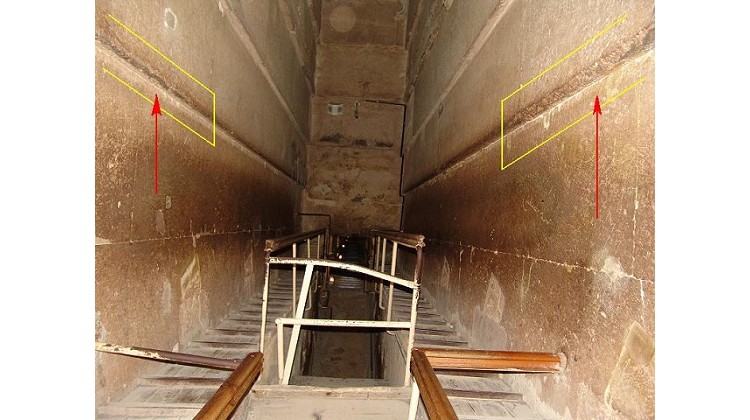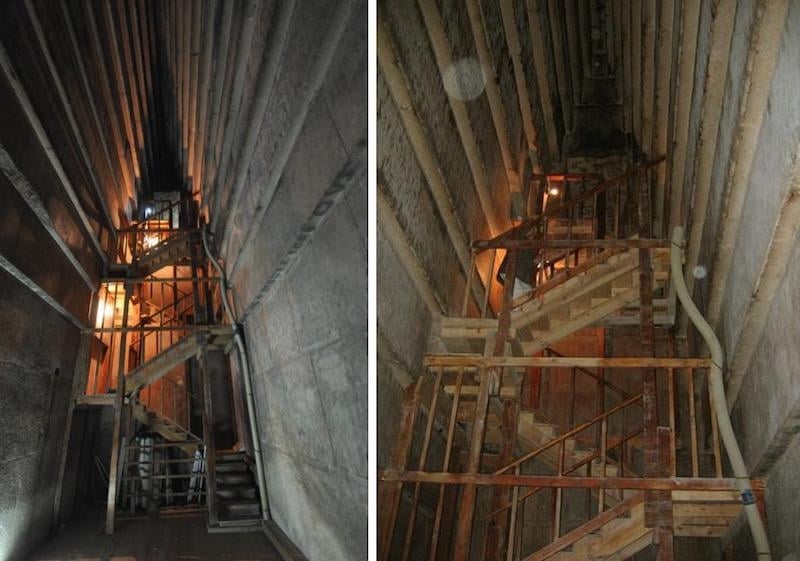Cavity detected by the same imaging mission that discovered a nine-metre corridor inside the structure
:quality(70)/cloudfront-eu-central-1.images.arcpublishing.com/thenational/UEH56QWNFVCVLJURC7GFLJ76YA.jpg)
The void is located directly above the Great Pyramid’s Grand Gallery, the long, narrow pathway that visitors of the pyramid use to access the King’s Chamber, one of four viewable rooms inside the structure.
The “Big Void”, the name given to it by the scientists, is encased in rock, so it is physically inaccessible. However, through non-invasive scans, its volume was reported to be several hundred cubic metres, one of the specialists involved in a large-scale scan of the ancient relic told The National.

It was discovered in 2017, one year after the detection of a smaller void that turned out to be the recently-announced hidden passage.
Since its discovery, the Big Void has been left largely unstudied because of its location in the centre of the pyramid.
Its function remains a mystery to those who have studied it, Sebastien Procureur of the French Alternative Energies and Atomic Energy Commission (CEA) told The National.

Mr Procureur was one of an international mission of scanning and imaging experts who participated in the ScanPyramids initiative, formed in 2015.
The mission used cutting-edge technology to attempt to decipher how the pyramids were built and how they have managed to stay standing for so long, questions that remain unanswered after eight years of scans.
:quality(70)/cloudfront-eu-central-1.images.arcpublishing.com/thenational/MMX6N6TEC5AYPHRDSCBZMR7SYY.png)
“We still have so much to learn from this amazing monument, despite the fact that it has been an object of interest for thousands of years,” Dr Salima Ikram, a renowned Egyptologist, told The National.
“Modern technology is really the only way in which we can penetrate its secrets. It really is a three-dimensional puzzle.”
Big Void ‘deep inside pyramid’

Unlike the smaller void, which was easy to study, the Big Void posed a serious challenge to the team.
“The reason we focused on the other, smaller void, which was recently announced, was because it is closer to the surface of the pyramid, which makes it infinitely easier to explore and study,” Mr Procureur said. “The Big Void is deep inside the pyramid, which makes measurements harder.”
Some members of the team thought there might be a connection between both voids and hoped that by studying the more accessible one first, it could provide more information on the larger void.
No such connection has so far been found.

“Whether it is a chamber, or a construction anomaly, or something else is not possible to say at this time. But my view on it has always that it is there, it is big and it is worthy of further investigation,” said Peter Der Manuelin, a professor of Egyptology at Harvard University.
Mr Procureur said further exploration of the Big Void would most likely involve alterations to the ancient structure that must be carefully considered.
“The Big Void is very central in the pyramids, so if one day, they decide to study it more closely, it will be quite complicated. A hole would have to be drilled to allow more precise detectors to reach it. It would have to be between five and 10 metres in length,” he said.
From the data available, archaeologists have wagered a number of interpretations regarding the function of the void.
While some thought that it was a relieving chamber to decrease the weight on the Grand Gallery, Mr Procureur said, simulations conducted by the team ruled this out because the void is too far above the gallery, around 10m, to provide any structural support.
Another interpretation was that it was another Grand Gallery — a passage that the pyramid’s builders used to move around its inside that was somehow sealed over time, he said.
Some archaeologists guessed it was an ancient anti-seismic chamber built to reduce the destructive effects of an earthquake.
Cutting edge imaging
:quality(70)/cloudfront-eu-central-1.images.arcpublishing.com/thenational/KROQGRARINDVPNZ7JT6NEK7DT4.jpg)
The ScanPyramids project used three different kinds of imaging technologies to complete the scan.
The first kind was muography, a type of non-invasive penetrative imaging that tracks the path of muons, an unstable subatomic particle produced when cosmic rays enter the Earth’s upper atmosphere. It is somewhat similar to x-ray imaging.
Special detectors were placed inside the pyramid to track the movement of the muons over the structure, which, in turn, provided measurements on depth and density through which the team was able to detect whether they were looking at solid rock or empty spaces.
Providing actual images that can be seen and studied by archaeologists involved a second kind of technology called nuclear emulsion.
:quality(70)/cloudfront-eu-central-1.images.arcpublishing.com/thenational/E5GOKIW3LVAYFMVACVUUZMAWME.jpg)
ScanPyramids team observing SP-NFC with an endoscope.
Designed by Japanese scientists at Nagoya University, the nuclear emulsion process works in the same way as dark room photography development whereby the path of the muons, which possess a measurable electric charge, is then chemically rendered on a special kind of film.
“The big drawback of this process is that it needs quite an intense work-after for the development. You have the chemical development then the scanning and the digitisation and finally the analysis,” Mr Procureur said.
A third kind of imaging technology, gaseous detection, developed by the French team, was also used in the scan.
Small shafts inside the pyramid
There are smaller cavities in the Great pyramid that remain a mystery to scientists.
“This is why we can’t rule out a connection between the two voids, even though we didn’t immediately find one, because it could be that there are passages between them that are too small for muography to perceive,” said Mr Procureur. “Also the passages could have been blocked due to seismic shifts in the four millennia that the pyramids have been at Giza.”
A 1992 earthquake that destroyed much of Cairo caused significant damage to the pyramid and reduced its height by around 10m after some of the rocks in the outer layer were dislodged. The fallen rocks are still strewn around the pyramid and can be seen by visitors.
Though he does not anticipate that any more large voids will be found, Dr Procureur said there remains a number of other small shafts imperceptible to muography.
:quality(70)/cloudfront-eu-central-1.images.arcpublishing.com/thenational/LDMVDPLPCRDC7MZKDGDZ4BFWYU.jpg)
Cairo University and TUM _ Ultrasonic Testing measurements on Chevrons area.
“There are shafts leading out of both the King and Queen’s chambers. They are about 30cm in width so they’re too small for a human to fit through,” he said. “These are still a mystery even after multiple robotic explorations. They are definitely man-made. It leaves something for future generations to understand.”
The idea to conduct the scan was put forth by Dr Hany Helal, a professor of engineering at Cairo University, who put the team of specialists together. The project was overseen and facilitated by the Egyptian antiquities ministry and multiple Egyptian specialists contributed to the project.
While Mr Procureur’s team has concluded its research at the Giza plateau, the Nagoya University team will continue to scan the structure and study the Big Void.
“We still have some unpublished findings about the void which we will release in the near future,” he said.








